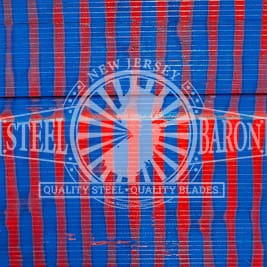- Joined
- Jul 4, 2010
- Messages
- 858
The BladeForums.com 2024 Traditional Knife is available! Price is $250 ea (shipped within CONUS).
Order here: https://www.bladeforums.com/help/2024-traditional/
NJSB does not sell AEB-L, they only sell X65cr13. AEB-L is an Uddeholm product. 13c26 is a Sandvik product very similar to AEB-L. Properties are similar, but I feel quality of the Uddeholm and Sandvik products are more consistent and have fewer impurities. I think Uddeholm has the patent on AEB-L, but they don't seem to enforce it.Interesting feedback thanks all - as I noted my stock was ordered as AEB-L from NJ steel baron .094 thickness, 48" length 2" width. I would be curious where the OP got his steel from.
it SEEMED to take an"AEBL" heat treat (plate quench/cryo with dry ice slurry) with good results, (although this is just going by using hardness testing files, without any scientific data). I have never worked with X65cr13 or 14C28N, do they have similar heat treat and properties to AEBL?

 newjerseysteelbaron.com
newjerseysteelbaron.com
If you go to the heat lot specs for the steel it will tell you the steel type and where it is coming from. I'm guessing it's a combination of the slight composition difference and manufacturing differences.Interesting, it seems very deceptive to specifically label and describe it as AEB-L on their website, very odd to me.
Another question just for my curiosity and edification, why would a steel like X65cr13 be expected to exhibit the "banding" and AEBL not?, if they are very similar in composition? just lower quality control/homogenization for the other manufacturers?

NJSB | AEB-L X X
A x x piece of AEB-L for sale! This piece of AEB-L finishes at thick and is .newjerseysteelbaron.com
I think we came to the conclusion it is not AEB-L, but X65cr13Are we sure it’s AEB-L?
I’m assuming stock removal and if so that’s super weird. I’ve done acid stone wash of AEB-L before and I’ve never seen thing like that.
